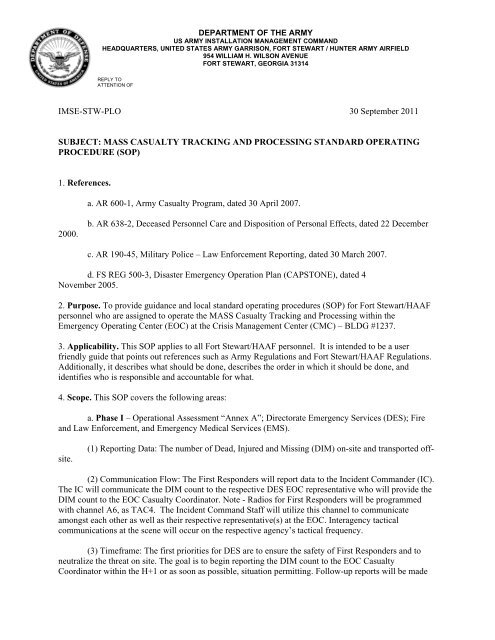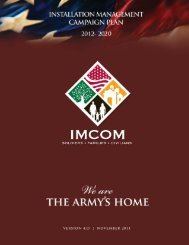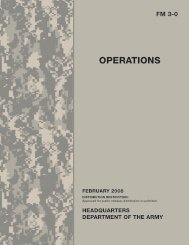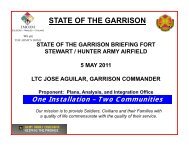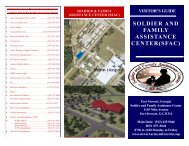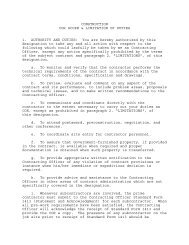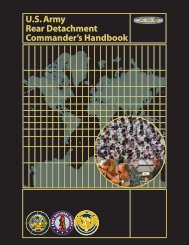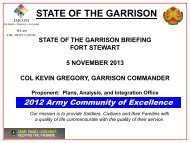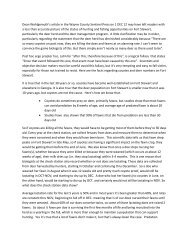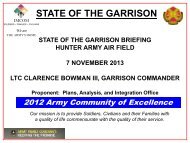3 - Fort Stewart - U.S. Army
3 - Fort Stewart - U.S. Army
3 - Fort Stewart - U.S. Army
You also want an ePaper? Increase the reach of your titles
YUMPU automatically turns print PDFs into web optimized ePapers that Google loves.
DEPARTMENT OF THE ARMY<br />
US ARMY INSTALLATION MANAGEMENT COMMAND<br />
HEADQUARTERS, UNITED STATES ARMY GARRISON, FORT STEWART / HUNTER ARMY AIRFIELD<br />
954 WILLIAM H. WILSON AVENUE<br />
FORT STEWART, GEORGIA 31314<br />
REPLY TO<br />
ATTENTION OF<br />
IMSE-STW-PLO 30 September 2011<br />
SUBJECT: MASS CASUALTY TRACKING AND PROCESSING STANDARD OPERATING<br />
PROCEDURE (SOP)<br />
1. References.<br />
a. AR 600-1, <strong>Army</strong> Casualty Program, dated 30 April 2007.<br />
2000.<br />
b. AR 638-2, Deceased Personnel Care and Disposition of Personal Effects, dated 22 December<br />
c. AR 190-45, Military Police – Law Enforcement Reporting, dated 30 March 2007.<br />
d. FS REG 500-3, Disaster Emergency Operation Plan (CAPSTONE), dated 4 …………<br />
November 2005.<br />
2. Purpose. To provide guidance and local standard operating procedures (SOP) for <strong>Fort</strong> <strong>Stewart</strong>/HAAF<br />
personnel who are assigned to operate the MASS Casualty Tracking and Processing within the<br />
Emergency Operating Center (EOC) at the Crisis Management Center (CMC) – BLDG #1237.<br />
3. Applicability. This SOP applies to all <strong>Fort</strong> <strong>Stewart</strong>/HAAF personnel. It is intended to be a user<br />
friendly guide that points out references such as <strong>Army</strong> Regulations and <strong>Fort</strong> <strong>Stewart</strong>/HAAF Regulations.<br />
Additionally, it describes what should be done, describes the order in which it should be done, and<br />
identifies who is responsible and accountable for what.<br />
4. Scope. This SOP covers the following areas:<br />
a. Phase I – Operational Assessment “Annex A”; Directorate Emergency Services (DES); Fire<br />
and Law Enforcement, and Emergency Medical Services (EMS).<br />
(1) Reporting Data: The number of Dead, Injured and Missing (DIM) on-site and transported offsite.<br />
(2) Communication Flow: The First Responders will report data to the Incident Commander (IC).<br />
The IC will communicate the DIM count to the respective DES EOC representative who will provide the<br />
DIM count to the EOC Casualty Coordinator. Note - Radios for First Responders will be programmed<br />
with channel A6, as TAC4. The Incident Command Staff will utilize this channel to communicate<br />
amongst each other as well as their respective representative(s) at the EOC. Interagency tactical<br />
communications at the scene will occur on the respective agency’s tactical frequency.<br />
(3) Timeframe: The first priorities for DES are to ensure the safety of First Responders and to<br />
neutralize the threat on site. The goal is to begin reporting the DIM count to the EOC Casualty<br />
Coordinator within the H+1 or as soon as possible, situation permitting. Follow-up reports will be made


